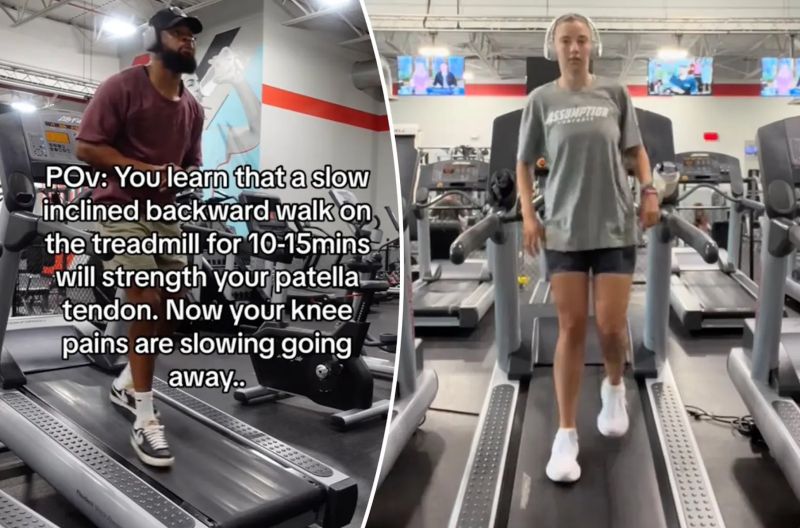January is the time the local gyms get overrun with new recruits attempting to get in shape for the new year. We have all seen the hilarious Instagram post where a daily gym customer walks through the front door of his gym and is greeted by newcomers using the gym equipment improperly. You have to laugh!
However, don’t snicker at the person walking backwards on the treadmill.
Knee osteoarthritis is a common disease and compromises the health of the elderly. With the worldwide epidemic of obesity and the aged population, the prevalence of osteoarthritis is exploding. This is a serious global concern. Individuals with knee osteoarthritis have poor balance, stability problems, and impaired proprioception. These problems are made worse with increased joint swelling, pain and stiffness. Falls are very common in these people resulting in bone fractures or fatal injuries. Posture control is viewed as a key factor in the incidence of falls. Imbalance in the center of gravity could be modulated by exercise. Proprioception impairment causes problems with limb muscle coordination and in the patients with knee osteoarthritis, this causes loss of postural control. Pain is a primary factor in improper balance during ambulation and is a recognized etiology for falls in the OA patient. Medications can help alleviate the pain as well as other modalities such as hyaluronic acid injections and platelet rich plasma. However, these modalities are not effective in improving balance, stability and impaired proprioception.
In recent years, with the increasing numbers of patients with knee osteoarthritis, the exploration of clinical practices for the treatment has led to complementary and alternative methods of therapy such as Tai chi and other forms of exercise. Backward walking was found to be an excellent physiotherapy treatment for OA knee patients. In several studies, it was suggested that this modality decreases pain, increases function, adds to muscle strength and performance. The results also showed improvement in balance and overall, less falls were recorded over time when compared to control groups.
In a study in 2015, backward walking exercise was reported as an effective method for improving equilibrium of the human body and the muscle strength of the lower limb in treating patients with lower limb disease. In China, some traditional Chinese medicine doctors frequently advocated it as a useful physical exercise and a substantive treatment of knee osteoarthritis. When the biomechanics were investigated, the features of backward walking showed a reduction in the loading of the knee during gait.
In another study, a randomized controlled trial investigated the effect of backwards walking on static stability, proprioception, pain and function. The findings showed a significant change after a 4 week period when compared to age matched OA patients. The conclusion was that backwards walking was an adjunctive enhancement and in coordination with conventional treatments the patients had a more favorable effects in stability, pain relief and functional improvement. This demonstrated the advantage of backwards walking that was not previously observed in the treatment of osteoarthritis of the knee.
It also proved that backwards walking improved gait speed and stride length. It enhanced quadriceps muscle strength, hamstring flexibility and overall physical function.
Proprioception includes the sense of position and movement and the sense of effort, force and heaviness. The tendons and muscle spindles are the two major mechanoreceptors. Muscle weakness or atrophy is one of the earliest symptoms of osteoarthritis. Due to the muscle problem, it is difficult for these patients to have full recovery with proprioception and longer periods of therapy are needed. (greater than 4 weeks in this study).
The final conclusion of this study was compared to the control, knee osteoarthritis patients treated with backwards walking for 4 weeks in combination with conventional treatment showed a greater reduction of pain and functional disability and had a greater improvement in static stability.
Effects of Backward Walking Exercise Using Lower Body Positive Pressure Treadmill on Knee Symptoms and Physical Function in Individuals with Knee Osteoarthritis: A Protocol for RCT
J Orthop Surg Res 2023 Apr 1;18(1):264 PMID 37005596
Objectives: The primary aim is to compare the effects of backwards walking exercise to forward walking exercise on knee pain, knee functions and thigh muscle strength in individuals with moderate knee osteoarthritis using lower body pressure in addition to mobility functions, balance and self-reported health status.
Conclusion: Using lower body positive pressure may have a promising result against knee osteoarthritis. Moreover, walking backwards exercise using lower body positive pressure might add more benefits to individuals with knee osteoarthritis.
(lower body positive pressure is an anti-gravity treadmill)
This study also noted backward walking exercise was efficacious in reducing compressive stresses at the patella-femoral joint when compared to forward walking.
Evid Based Complement Altern Med 2021 Jun 11:2021:5574966 PMID 34221078
Objective: Impaired static stability and proprioception have been observed in individuals with knee osteoarthritis which serves as a major factor increasing the risk of falls. This study aimed to investigate the effects of backward walking on static stability, proprioception, pain, and physical function in KOA patients.
Conclusion: Backward walking is an effective adjunct to conventional treatment in reducing pain, improving physical function and static stability for KOA patients. It should be taken into consideration when developing rehabilitation programs for people with KOA.
The Immediate Effect of Backward Walking on External Knee Adduction Movement in Healthy Individuals
J Healthc Eng 2022 Nov 11:2022:4232990 PMID 36406334
The knee is one of the most important load bearing joints during daily activities. During level walking, the forces across the knee are not distributed symmetrically between the medial and lateral compartments. Over 60% of the loading force goes through the medical compartment of the knee. This asymmetry in the distribution of force leads to a higher medial knee loading during gait. In this study, the force is measure at the knee with forward and backward walking.
Conclusion: The results of our study confirmed the significant biomechanical function of backward walking in reducing the knee joint loading. We suggested that backward walking may potentially be a viable strategy in reducing medial joint compartment loading for individuals with medial joint knee osteoarthritis.
Author note; The results of these studies has proven backwards walking has a significant place in the treatment of osteoarthritis of the knee. Reduction in patellar femoral joint as well as medial compartment forces were noted. Muscle strength, reduction in pain, greater flexibility, improved gait and stride were all noted. Static stability, proprioception and overall physical function were all increased in patients with osteoarthritis of the knee when backward walking was added to their treatment protocol.
So, when you go into your local gym or physical therapy facility and see people walking backwards, don’t laugh as that movement has significant advantages in the treatment of osteoarthritis.
Integrative Practice Solutions has been involved in the treatment of osteoarthritis of the knee for greater than a decade. IPS has mentored hundreds of medical professionals in the patented AARP protocol. This protocol employs the use of hyaluronic acid injections under guidance into the osteoarthritic knee joint. The AARP protocol also includes an unloading brace and an aggressive physical therapy program. IPS understands the importance of each and every part of the protocol with major emphasis on physical modalities such as walking backwards.
If you are in the medical field and treating patients, it is a foregone conclusion those patients have or will develop symptomatic osteoarthritis of the knee joint. Integrative Practice Solutions is ready to enhance your care in the treatment of these patients.
Regenerative Regards,
Dr. Robert McGrath



